The best folk remedies for treating cucumbers against diseases
When growing cucumbers, gardeners often encounter problems with yellowing and wilting of leaves, curling of fruits, and death of the vine. These are signs of cucumber diseases. If you ignore these symptoms, you risk losing your crop completely. Treating cucumbers against diseases with folk remedies is an effective and safe method of therapeutic effects.
In this article we will tell you everything about cucumber diseases and their treatment with folk remedies. We will teach you how to identify diseases, which recipes are most effective to combat them, and how to properly prepare and use medications.
Descriptions and symptoms of cucumber diseases
You can help the plant only if the diagnosis is correctly established. Cucumber is a vine plant that grows naturally in tropical forests and loves a humid climate. Violation of growing technologies weakens the plant’s immunity, reducing its resistance to disease.
Let's look at the symptoms of the disease in detail:
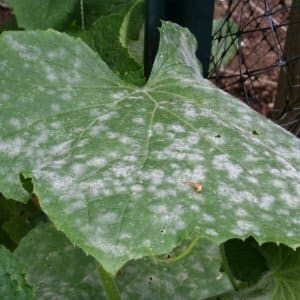
- White coating on the leaves indicates a fungal disease – powdery mildew. The disease affects leaves and fruits. The fungal spores that cause powdery mildew actively reproduce in rainy weather. Conversely, hot weather helps fight the disease. Look at the photo of leaves affected by the disease.
- The leaves are covered with small light yellow spots - signs peronosporosis, downy mildew. The leaves gradually change color, become brown, then dry up along with the vine.This fungal disease actively develops at high humidity.
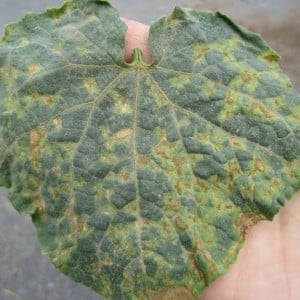
- Olive spots on leaves and stems indicate a disease - brown olive spot, cladosporiosis. Brown ulcers appear on the affected fruits. Within a week, the entire plantation may die. The disease progresses with temperature fluctuations, cold nights, and heavy dew.
- Fusarium wilt is common in greenhouses.. The disease begins from the top of the plant, then moves to the root collar, the bush stops bearing fruit and dies. Predisposing factors for the onset of the disease are heat and lack of ventilation in the room.
- High humidity, cold weather, dense bushes can affect development gray rot. A gray coating appears on the fruits, then fluff, after which the plant dies.
- Many white spots on the leaves indicate a disease white rot. Over time, the plant becomes covered with a slippery coating. The disease is transmitted by sclerotia fungi, which love a moist environment.
- The roots of the cucumbers turn brown and dry out. These are the signs root rot. The plant can get sick at any stage of growth.
- Yellow-green mosaic pattern – viral disease mosaic field It is carried by aphids. The leaves curl, stop growing and disappear.
- If yellow and white spots are found on the leaves, which eventually merge into one large spot, there are signs of a white and green mottled mosaic. The leaves of the cucumbers turn white and green veins appear on them. Small depressions are visible on the fruits. The fruits harden and the skin turns yellow. The virus is transmitted through contaminated seeds or soil. The disease progresses with a sharp change in temperature.
For what reason can cucumbers get sick?
Growing cucumbers is not easy; the plant requires care.
Let's look at the main causes of cucumber diseases: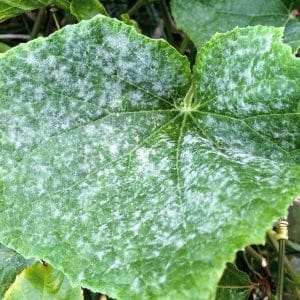
- unbalanced watering (lack or excess of moisture);
- excess nitrogen fertilizers;
- high humidity;
- violation of crop rotation;
- lack of magnesium, potassium;
- darkened landing site;
- watering from above onto the leaves;
- use of cold water;
- contaminated soil or tools;
- dense planting.
The use of folk remedies in the fight against cucumber diseases: advantages and disadvantages
Folk remedies have a number of advantages over chemicals:
- they are environmentally friendly;
- accessible;
- cheap;
- easy to prepare.
But there are also certain disadvantages:
- the drugs must be used continuously throughout the season;
- Herbal infusions take a long time to prepare.
The best recipes and regimens for use against diseases
Cucumbers are susceptible to fungal, viral, and bacterial diseases. Treatment with traditional methods is carried out depending on the type of lesion. We have selected for you several folk recipes that will help in the fight against various diseases.
Iodine based mixtures
Iodine is an integral part of any first aid kit.. It can also be used in the garden to control and prevent fungal and viral diseases of vegetable crops. Iodine has an antiseptic and anti-inflammatory effect. To treat crops, mixtures with iodine are prepared based on milk, whey or water.
Preparation of a mixture based on milk or whey: 1 liter of product, 8 liters of water, 10 drops of iodine. Treat leaves and tops of plants every two weeks, starting from the moment the second leaf appears. The procedure is carried out throughout the growing season.
With ash
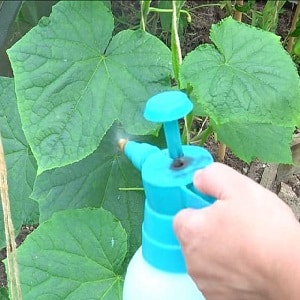
Ash is especially useful for acidic and podzolic soils. It is used to deoxidize soil.It is rich in potassium, magnesium, calcium and not only heals, but also nourishes plants, strengthening the immune system. Ash is added to the soil for digging, using 1 square meter. m of land 500 g of substance.
On cucumbers, ash is used to combat powdery mildew and aphids. Bushes and leaves are powdered with dry ash, which helps in the fight against aphids. To prevent powdery mildew, use an aqueous solution: 1 glass of ash, 8 liters of water. Spray the leaves, stems, water the ground around the plants. The procedure is carried out every two weeks.
Garlic solution
Garlic has antibacterial and antiviral properties. It is used in folk medicine, as well as in agriculture to treat plants against fungal and viral diseases.
Prepare an infusion: leave 100 g of chopped garlic in 1 liter of water for seven days, then dilute with 8 liters of water. Bushes are treated from all sides for prevention 3-4 times per season.
Important: Violation of proportions can lead to leaf burns.
Recipes with whey
The whey is saturated with lactic acids. It is used to prepare mixtures and treat cucumbers against fungal diseases. The whey is diluted with water in the following proportion: 1 liter of product, 8 liters of water. Treatment is carried out every week.
For greater effect, add 10 drops of brilliant green, 1 tbsp. l. liquid soap. Three times a season enriched with hydrogen peroxide: 1 tbsp. l. per 1 liter of solution.
Feeding with mullein solution
Mullein is the main food for cucumbers and at the same time a means of disease prevention. It contains all the necessary nutrients.
The plants are treated from above with a solution of liquid mullein using a broom. Prepare the mixture in the following proportion: 1 liter of mullein, 10 liters of water. 3-4 procedures per season are enough.Living organisms found in mullein actively fight pathogenic bacteria, preventing the development of the disease.
Important. Start processing immediately after the second leaf appears.
Other recipes effective in fighting diseases
Treatment of cucumbers against diseases using traditional methods is safe. Mixtures, decoctions, and infusions are easy to prepare. The ingredients for them are available, many are “under our feet.”
Here are some examples:
- Celandine – pick a bunch of grass, place it in a bucket of water, leave for a week. Spray leaves and stems once a week. This remedy will help get rid of fungal diseases.
- Soda with iodine will destroy aphids. If the cucumber leaves have a pale appearance, it means that aphids have settled on the back side. Spray with a solution of soda with iodine: 1 liter of water, 1 tbsp. l. soda, 5 drops of iodine. Treatment is carried out only if necessary.
- Zelenka will always be in your home medicine cabinet. With its help, they get rid of diseases and feed cucumbers. The solution is prepared: 1 liter of water, 5 drops of brilliant green.
Preventive treatment of cucumbers
A rich harvest depends on many factors. We list the main ones:
- It all starts with preparing the seeds: heating, hardening, soaking in a light pink solution of potassium permanganate for disinfection.
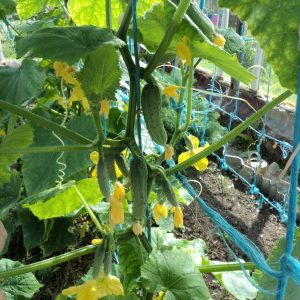
- Soil preparation. Sufficiently fertilized soil will fill the plants with nutrients, strengthen the immune system, and make cucumbers resistant to disease.
- Uniform landing. It is important to maintain a distance of 15-20 cm between plants in open ground.
- Immediately after the appearance of the second leaves, in order for the plant to gain strength, fertilize with nitrogen fertilizers. Use a solution of ammonia: 1 tbsp. l. ammonia per 8 liters of water. Water 0.5 liters at the root.
- In the future, feed with mullein every two weeks (1 liter of mullein, 10 liters of water). Alternate foliar and root feeding. Water the leaves and stems generously with the solution.
- Use a solution of brilliant green, alternating it with whey and iodine.
Watering from above onto the leaves is one of the reasons for the spread of diseases on cucumbers.
Conclusion
In this article, we analyzed the causes of cucumber diseases and found out the characteristics of viral, fungal and infectious diseases.
You can treat cucumbers against diseases with folk remedies such as: iodine, whey, ash, you can get an environmentally friendly and safe product for health. The article presents unique recipes from celandine, brilliant green, and soda. By following the technology of growing, watering, and fertilizing, you will prevent the development of most known diseases of garden crops.